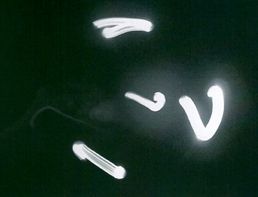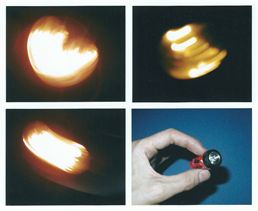| R e s e a r c h
T r i a n g l e s o v e r B e l g i u m page 1 | 2 | addendum
Famous Belgian UFO photo a hoax
We're in the Summer of 1990. The publicity surrounding the Belgian UFO wave has almost died down when a reporter of RTL [1], one of the country's most popular TV channels, alerts SOBEPS to a spectacular piece of new evidence: it appears that someone in the community of Petit-Rechain, not far from the city of Liège, has managed to capture a close-up shot of the mysterious craft which so many had seen sailing the Belgian skies since late November 1989. The fortunate photographer is one Patrick M., a 20 year old turner fitter. Patrick had taken the photo from the small terrace at the back of the house he shares with his fiancé Sabine.
As the story goes, one evening in April (presumably April 4th), Sabine was letting the dog out in the backyard when she spotted a series of strange stationary lights in the sky. She immediately called out to Patrick who had stayed inside. The latter grabbed his reflex camera loaded with colour reversal film, ran to the terrace, positioned himself against a wall and snapped two photos. Immediately thereafter the lights began to move and disappeared behind a neighbour's house [2]. A few days later the developed slide film came back from the local photo shop. Much to their surprise the couple found that one photo had turned out perfectly clear, whilst the second showed nothing but blackness. The bad slide was thrown away; the good one kept in a drawer until photo journalist Guy MOSSAY, working for the country's major press agency BELGA, picked up the story. But here the truth becomes blurred.
According to MOSSAY, the witness/photographer had contacted him at his office in an attempt to sell the original slide and collect some money for his upcoming wedding [3] (rumours have it that between 250 and 500 euro was paid). Patrick M., however, claims it was one of his colleagues from work who had approached MOSSAY. He insists that he himself never got any money for the slide but had only lend it to MOSSAY [4] [5]. Whatever the truth, MOSSAY got hold of the original and secured its copyright through SOFAM, a Belgian collective for visual arts authors that collects and redistributes royalties. Thinking it would be a good idea to exploit this rare piece of evidence in the media, MOSSAY mailed copies of it to BELGA and to various newspapers, magazines and TV stations, including RTL. The first to publish the slide was the French journal Science et Nature [6]. One by one the rest of the media followed and it didn't take long before the Petit-Rechain photo started its march across the world. 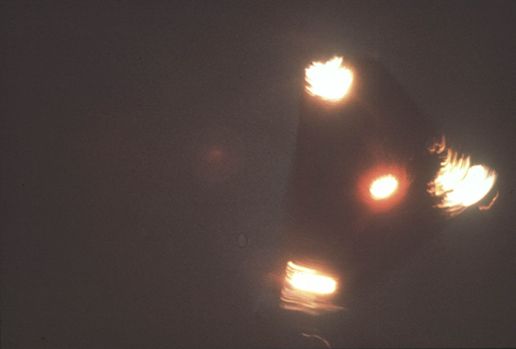
Photos and videos allegedly showing "THE" Belgian UFO had been aired on television before but all these images proved either unconvincing or easily identifiable as ordinary aircraft lights or out-of-focus images of astronomical bodies and streetlights. This time, however, it looked as if someone had finally captured the real thing on film. Moreover, overexposed images had revealed a dark triangular structure behind the photographed lights which had not been noticed at first.
Analyses conducted by Prof. Auguste MEESSEN, a physicist with a lifetime interest in UFOs and associated with the Université Catholique de Louvain-La-Neuve(UCL), concluded that the lights in the photo were probably plasma jets from a high-tech alien spacecraft and that U.V. light from the vehicle had influenced the image on the film emulsion (remember that the witnesses mentioned seeing only small lights, not the vast carrousels of light that can be seen in the picture). [7].
Further analysis of the slide, notably by Dr. Richard F. HAINES, former senior scientist with NASA and Chief Scientist for the American National Aviation Reporting Center on Anomalous Phenomena (NARCAP)[8], Professor François LOUANGE, French specialist in satellite imagery working for the military, the European Space Agency and the Centre National de la Recherche Scientifique (CNRS) [9], André MARION, Doctor in nuclear physics, professor at the University of Paris-Sud and former research engineer also with CNRS [10] [11] and Benoît MUSSCHE, expert in medical imagery and head analyst with SeerSight Image Analysis [12], all endorsed the extraordinary properties of the shot.
In the History Channel documentary Special Access - UFOs On The Record, premiered on August 26, 2011, investigative journalist Leslie KEAN referred to the Petit-Rechain photo as "one of the most convincing" pieces of evidence for the existence of UFOs. The show was based on KEAN's best-selling book UFOs: Generals, Pilots, and Government Officials Go on the Record (Harmony Books, New york, 2010).
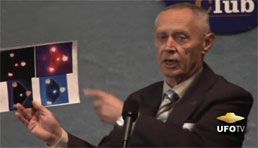
Then, in a news item broadcast by RTL on July 26, 2011, i.e. exactly one month before the then already completed History Channel documentary hit the air, Patrick M. confessed that the photo he had taken 21 years earlier was merely part of a prank he had concocted with a friend from work. In subsequent interviews Patrick revealed that it was his friend who had cut out a 60 to 80 cm wide triangle from a piece of Styrofoam whilst he himself had squeezed four flashlights in the model, painted the middle one red with a marker, and suspended the lot with the help of a couple of wires and a kitchen step ladder. The idea for the hoax had entered his mind after having discussed the Belgian UFOs with some of his colleagues at the factory who shared his interest in photography [13]. All were in on the hoax, but in the end it was Patrick who took the pictures. He shot the scene from his backyard while Sabine remained inside, slightly bored with her fiancé's outdoor activities. Not two, but about a dozen pictures were taken. Unfortunately, the other shots have not been located yet. Patrick no longer lives in Petit-Rechain and it's possible that Sabine has them now. Asked about the chances of recuperating the other shots, Patrick replied that he will have a look but has no intention of bothering his ex with this story again [14].
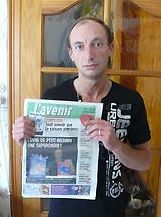
In hindsight, it turns out that the photo was fabricated in a way similar to the technique we suggested in a monograph published two years after the photo surfaced [15] At the time, both the original and our simulation photo were examined by Prof. Marc ACHEROY at the Royal Military School [16] [17]. The conclusion was that Patrick M. could never have faked the photo in this way. We then proposed several changes in the technique and let the matter rest until, 13 years later, in the light of a series of new analyses that were being conducted on the original, we set to work again and produced a set of new shots. This time the spotlights were replaced by small flashlights that were no longer placed behind a pierced cutout but screwed into the cardboard. The model was then suspended from a thin wire in front of a blue door that served as background sky [18].
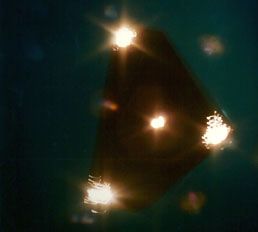
Despite the fact that all the "oddities" in the Petit-Rechain slide could be successfully copied in this way, Prof. ACHEROY repeated his conclusion that our technique would never explain the extraordinary characteristics of the original [19]. Patrick's recent confession showed this conclusion to be embarrassingly wrong: the UFO WAS a suspended model with small flashlights attached to it, though not made of cardboard but of Styrofoam.
But demonstrating that a UFO photo can be duplicated is not the same as proving that the original is a fake. The context in which the photograph is said to have been taken should be examined as well. If discrepancies are found between the witnesses' narratives and information contained in the photo, then this would seriously incriminate the evidence. In the case of the Petit-Rechain incident discrepancies were multiple and as early as 1992 we pointed to the following:
- A photo taken during the on-site investigation shows the scenery with the UFO sketched into it. The triangular object is situated close to the horizon. Yet, Patrick's photo shows the bottom of the object (impossible to predict the flight characteristics of interstellar craft, but a triangular design hovering on edge seems aerodynamically absurd).
- The image is too sharp for a distant object being photographed with a zoom lens and without the use of a tripod (it now turns out that Patrick M. did use a tripod).
- The photo contains no background information, making it impossible to judge the actual size of the photographed object.
- The stories told separately by the two witnesses did not match one another.
- Photographers who claim that they threw away pictures taken immediately before or after their "UFO" shot are often trying to hide evidence of unsuccessful attempts at fakery.
- Despite the fact that the apparent size of each of the lights in the picture equals that of the full moon, no one else in this rather densely populated region seemed to have noticed anything unusual in the sky that evening.
Of course we were not the only ones reluctant to accept an exotic interpretation for the Petit-Rechain slide. Daniel SOUMERYN-SCHMIT and Pierre MAGAIN of the Institut d'Astrophysique de Liège for instance had also expressed severe doubts about the slide's authenticity [20]. Especially MAGAIN - who had attempted to duplicate the slide by triple exposing a pierced cardboard box and changing the position of the light with each shot - had pointed to some of the problems cited above [21]. His viewpoint was shared by skeptic Marc HALLET [22] and physicist Roger PAQUAY whose detailed critique was published in the American online-journal SunLite just months before the hoax was revealed [23].
And what about Guy MOSSAY's current opinion on all this? In an interview with the Flemish newspaper De Standaard, the now retired reporter says to be frustrated and angry, not only because he was taken in by a young prankster but also because of what his former colleagues might think of him now that it's clear that he exploited a fake document. MOSSAY,now residing in France, insists that he had always believed the photo to be real, "not an alien spaceship but probably a secret plane of some sort" [24].
Barely three months before the news of the hoax hit the media, we met with former SOBEPS photo expert Patrick FERRYN, now head of COBEPS [25]. Back in August 1990, FERRYN, together with Guy BLESER, conducted the initial on-site investigation. We knew that Sabine and Patrick M. had ended their relationship a couple of years ago and figured it would be a good idea to contact Sabine again. Perhaps she would speak more freely now about what had happened 21 years ago. Seems like we missed a scoop here...
Wim VAN UTRECHT (October 2011)
Patrick M. has shown himself most helpful in answering questions from anyone who wants to know more about his prank. Since October 2011 he manages his own blog, a collection of borrowed articles on the strange and unusual. In an interview with Michel VANBOCKESTAL of the Belgian Research Centre for Unexplained Phenomena (CERPI) [26], Patrick explains that it were the witnesses' descriptions of "the Belgian triangle" that inspired him to build a lookalike model. He further asserts that he has always been a true believer ("I believe in UFOs, I believe in ufology and I'm sure the Belgian wave was the real thing").
[1] Radio Télévision Luxembourg
[2] Initial 3-page report drafted by Patrick FERRYN and Guy BLESER, copy of which was kindly submitted to the author by ex SOBEPS collaborator Godelieve VAN OVERMEIRE.
[3] De Standaard, July 30-31, 2011.
[4] FERRYN, Patrick, "Retour à Petit-Rechain" in Vague d'OVNI sur la Belgique, pp. 221-222.
[5] www.lavenir.net
[6] Science et Nature No. 6 (November 1990)
[7] www.meessen.net
[8] FERRYN, Patrick, "Retour à Petit-Rechain" in Vague d'OVNI sur la Belgique, pp. 242-246.
[9] Ibidem, pp. 241-242.
[10] "Un OVNI à la loupe" in VSD " Hors-série No. 6, November 2003, pp. 36-39.
[11] MARION, André, "Nouvelle analyse de la diapositive de Petit-Rechain" in Inforespace No. 111, December 2005, pp. 22-27.
[12] MUSSCHE, Benoît, "Le rapport SeerSight" in Inforespace No. 111, December 2005, pp. 28-41.
[13] RTL news item, July 26, 2011.
[14] Mail d.d. September 15, 2011 from Patrick M. in response to a series of questions put to him by Marc HALLET and the author.
[15] VAN UTRECHT, Wim, Triangles over Belgium - A Case of Uforia, Antwerpen, Belgium, 1992, pp. 10-12.
[16] FERRYN, Patrick, "Retour à Petit-Rechain" in Vague d'OVNI sur la Belgique, pp. 234-240.
[17] HENDRICKX, Peter, Bepaling van de impulsresponsie van een optisch system met als doel de restauratie van gemaakte beelden, civil engineer thesis, Academic Year 1991-1992.
[18] FERRYN, Patrick, "La photo de Petit-Rechain : un état de la question" in Inforespace No. 111, December 2005, pp. 16-18.
[19] Ibidem, p. 19.
[20] FERRYN, Patrick, "Retour à Petit-Rechain" in Vague d'OVNI sur la Belgique, pp. 246-247.
[21] MAGAIN, Pierre,"La photographie de Petit-Rechain", unpublished manuscript, kindly submitted to the author by Marc HALLET.
[22] HALLET, Marc - personal correspondence (see also Marc's personal assessment of the Petit-Rechain hoax at www.marc-hallet.be).
[23] PAQUET, Roger, "The Petit-Rechain Photograph" in SUNlite Vol. 3, No. 2, March-April 2011, pp. 19-22 (freely available at home.comcast.net).
[24] De Standaard, July 30-31, 2011.
[25] We quote from www.sobeps.org: "COBEPS (Belgian Committee for the Study of Space Phenomena) will ensure the continuation of some of the activities of SOBEPS. The committee reassembles some former collaborators and investigators regrouped by Patrick Ferryn (co-founder of SOBEPS with Lucien Clèrebaut, in 1971) and Léon Brénig (physicist, professor at the Université Libre de Bruxelles)".
[26] Centre d'Etude et de Recherche sur les Phénomènes Inexpliqués (www.cerpi.be). A digest of this interview can be found at portedutemps.net.
|
|




